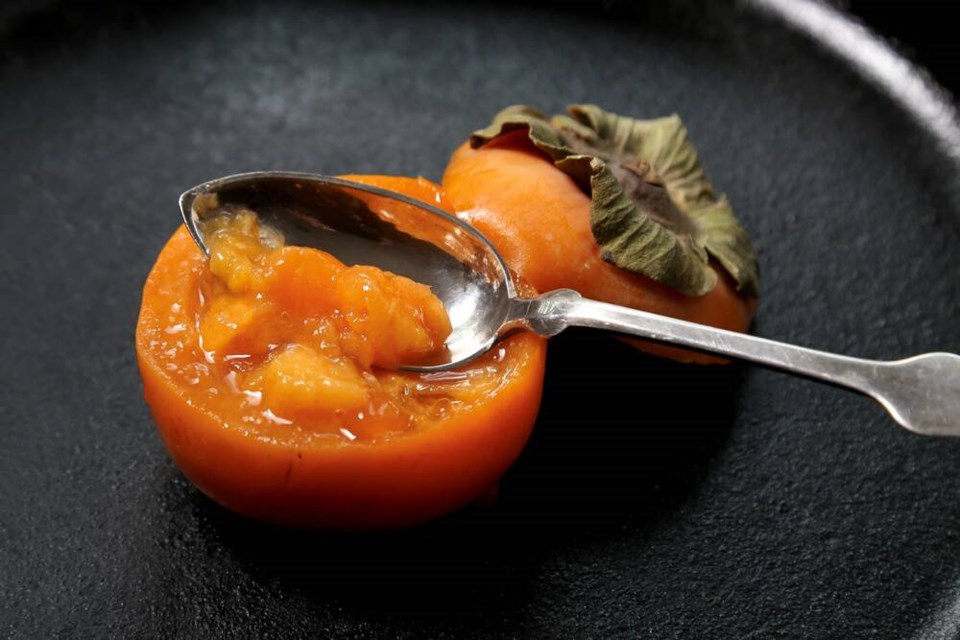Three years ago, I impulse-purchased a tiny Fuyu persimmon tree from a specialty nursery on Vancouver Island.
As a non-native species, the exotic tree did not qualify for inclusion in our small urban permaculture orchard of dwarf fruit trees. The fuyu, became an outlier.
Initially, our fuyu lived in a large terra cotta pot, where it flourished and bore fruit its very first winter —yes, winter. The following year, the tree was shaded to disadvantage by a newly established arbour, so we planted it into the centre of a small hugelkultur-mounded food forest built hastily during the lethal heat dome of 2021.
This act of resilience bore no fruit, initially. Lack of sunlight, transplant shock and heat stroke may have contributed to a corresponding lack of fruit set, though it is hard to know. Diospyros kaki, apparently, are prone to biannual fruiting.
What I know for sure is that our fuyu enjoys its new home. The warm and slow decomposition of wood trimmings and other garden-waste biomass buried in the hugelkultur mound has supercharged the fuyu and everything else in its new ecosystem.
Fuyu, which has been said to mean “wealthy” to Japanese people, and “food of the gods” to the Greeks, represents nothing short of miraculous to me. While native to Japan, fuyu persimmon seem perfectly suited to our local landscape and climate.
Persimmon wood is incredibly hard and seemingly impervious to the type of inadvertent wounding that introduces pathogens to less hardy fruit trees. The thick, broad and glossy leaves have remained blemish and blight free, and while they cling fast through all manner of weather during the growing season, they fall sharply and wholesale to the ground upon first frost. The adolescent fruit (berries technically) then, while left suddenly and entirely exposed to frigid elements, enjoy unimpeded access to the winter sun. How very clever.
Our initial fuyu harvest ripened just in time for Christmas, gifting us two full months to spectate while the jewel-like fruit sparkled alternately with dew, rain, frost and ice — naked against the grey winter sky. The fruit presented initially as tiny, light green, bum-like orbs, and then morphed spectacularly into brilliant mango and pumpkin coloured offerings wrapped in paper-thin skin as smooth and transparent as porcelain.
This year, our small fuyu bears a dozen or so fruit at various stages of ripeness, which, given its part sun-location, is spectacular. I am enchanted by the colours, ranging in proximity to sunlight, from the palest of green, to a balayage of golden apricot.
I shall prune the tree over time, to remain below three metres in height, and encourage mid-level lateral branching. Ideally, this will create a fruit-bearing canopy for our tiny food forest of just 30 square metres in size.
Vitamin and mineral-rich fuyu are powerfully high in chronic disease-fighting antioxidants. Ripe fruit is remarkably delicious, promising a juicy melange of melon, apricot and papaya. Unripe fruit can be speed-ripened inside a closed paper bag. Adding a banana or apple to the mix will increase the concentration of ethylene gas, and hasten maturation. Unripe fuyu stores well for weeks in a cool garage, and ripe fruit lasts several days in the fridge.
Our fuyu tree is a much-loved exception to our permaculture plantings. Admittedly, I should not encourage gardeners to buy non-native, but also I cannot help but celebrate this incredibly resilient tree that bears fruit when all else in the garden lies dormant. She has much to teach us.
This holiday season, fuyu will figure prominently on our appetizer and dessert menus. Pantry staples can be called into service without notice, to create beautifully simple one-bites like prosciutto-wrapped wedges of firm ripe fuyu. Meltingly ripe fuyu pulp pairs beautifully with smoked cheddar on herby seed crackers, or atop a phyllo-wrapped baked brie or goat cheese dusted with Asian or South Asian spices.
And for dessert? Cut just-ripe fuyu in half horizontally, drizzle flesh with maple syrup, pomegranate molasses or dark honey; add the tiniest sprinkle of sea salt, and then broil until golden. Serve with thick mapled cream or whipped ricotta, and finish with a whisper of citrusy sumac.
Laura Marie Neubert is a West Vancouver-based urban permaculture designer. Follow her on Instagram @upfrontandbeautiful, learn more about permaculture by visiting her Upfront & Beautiful website or email your questions to her here.
For a taste of permaculture, click on the YouTube link below:
(Video - Courtesy of West Vancouver Memorial Library)



